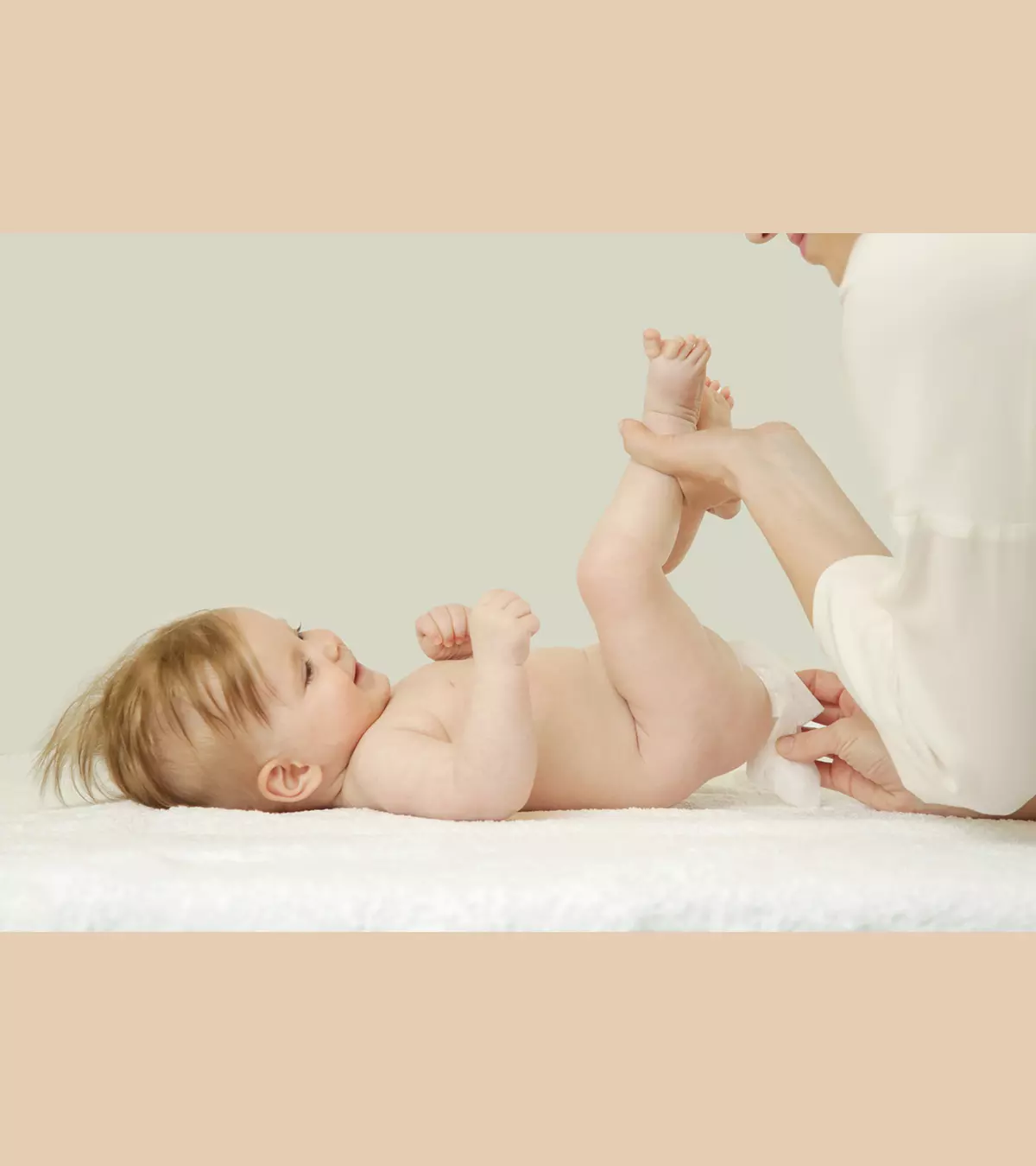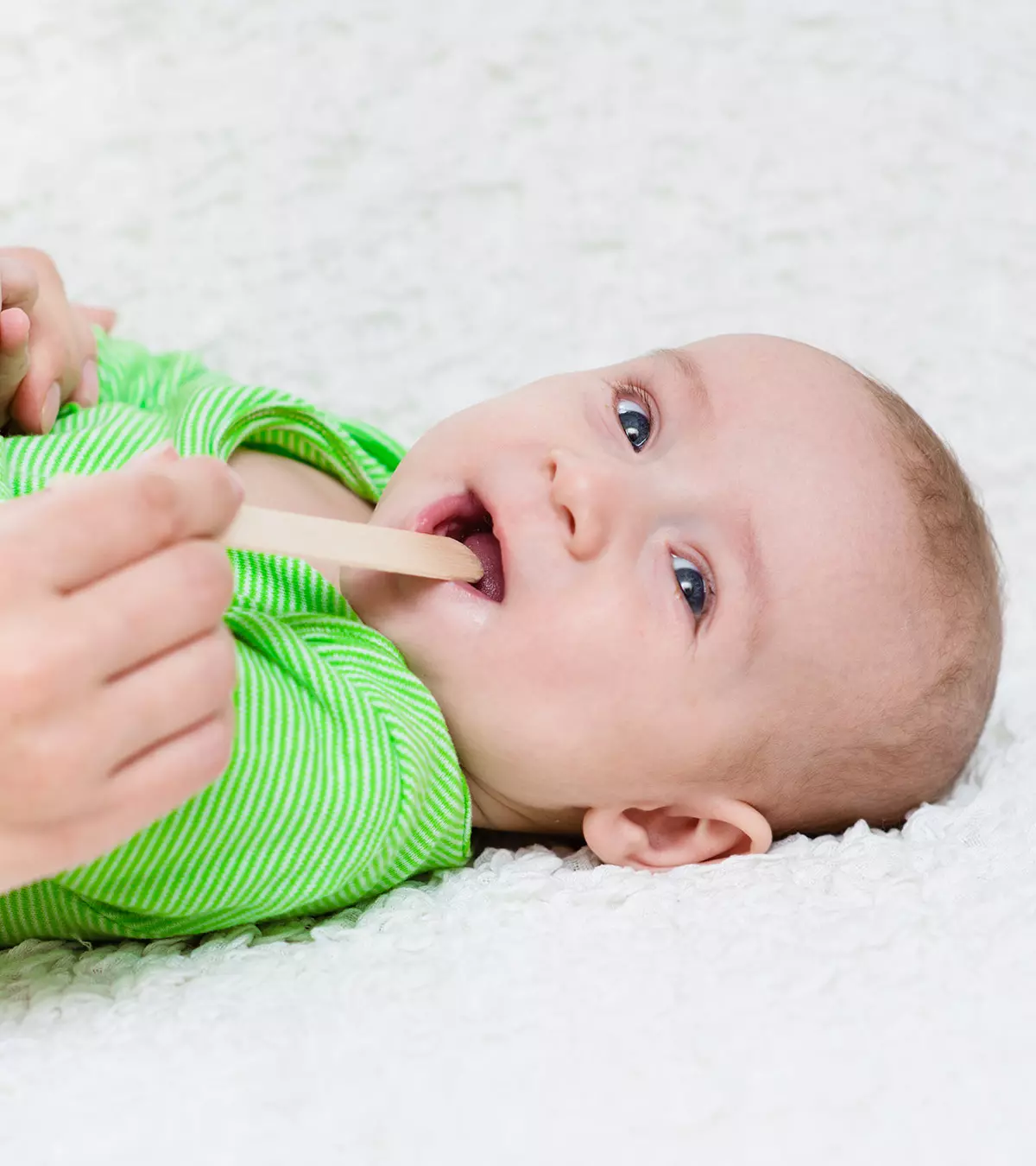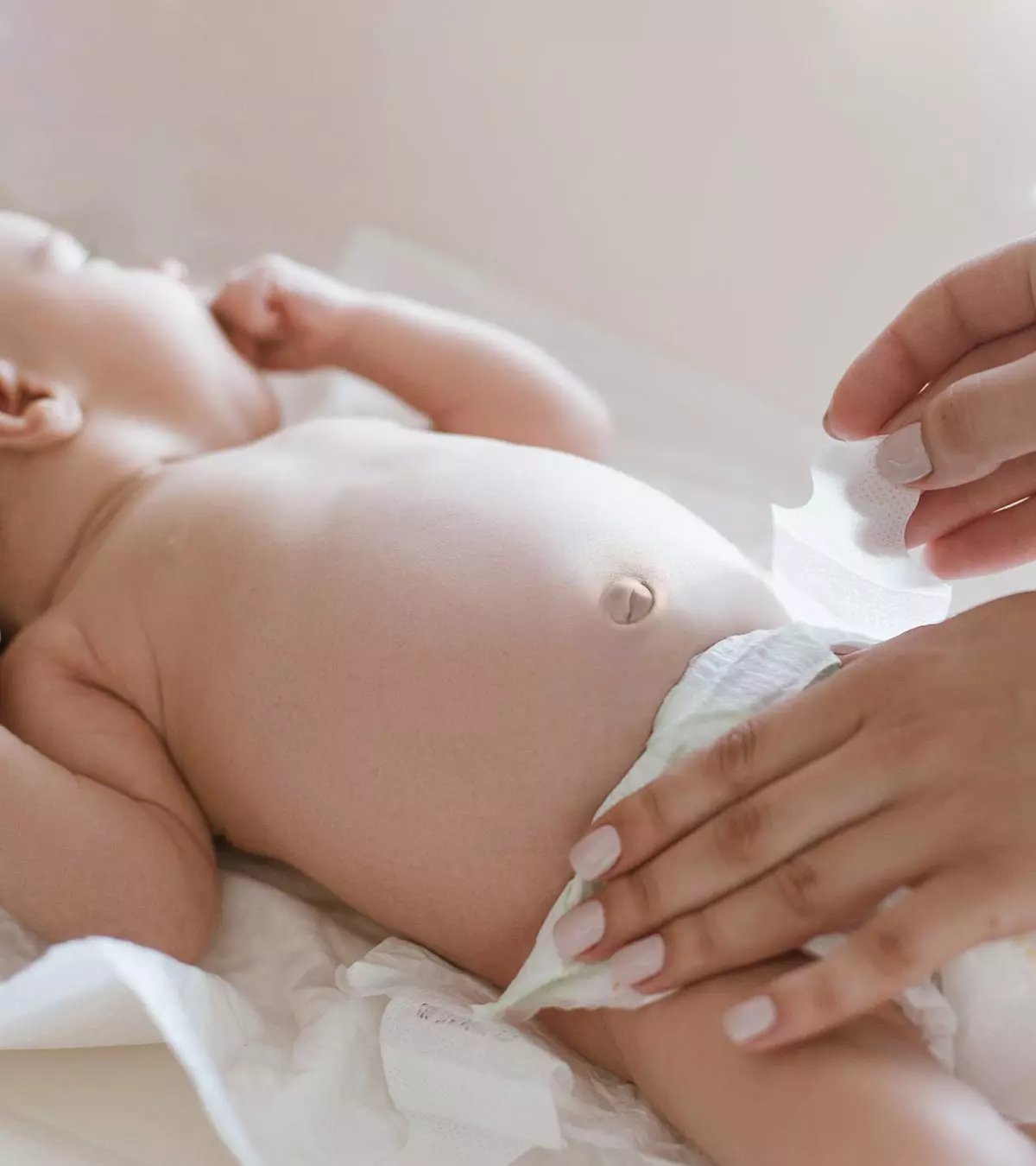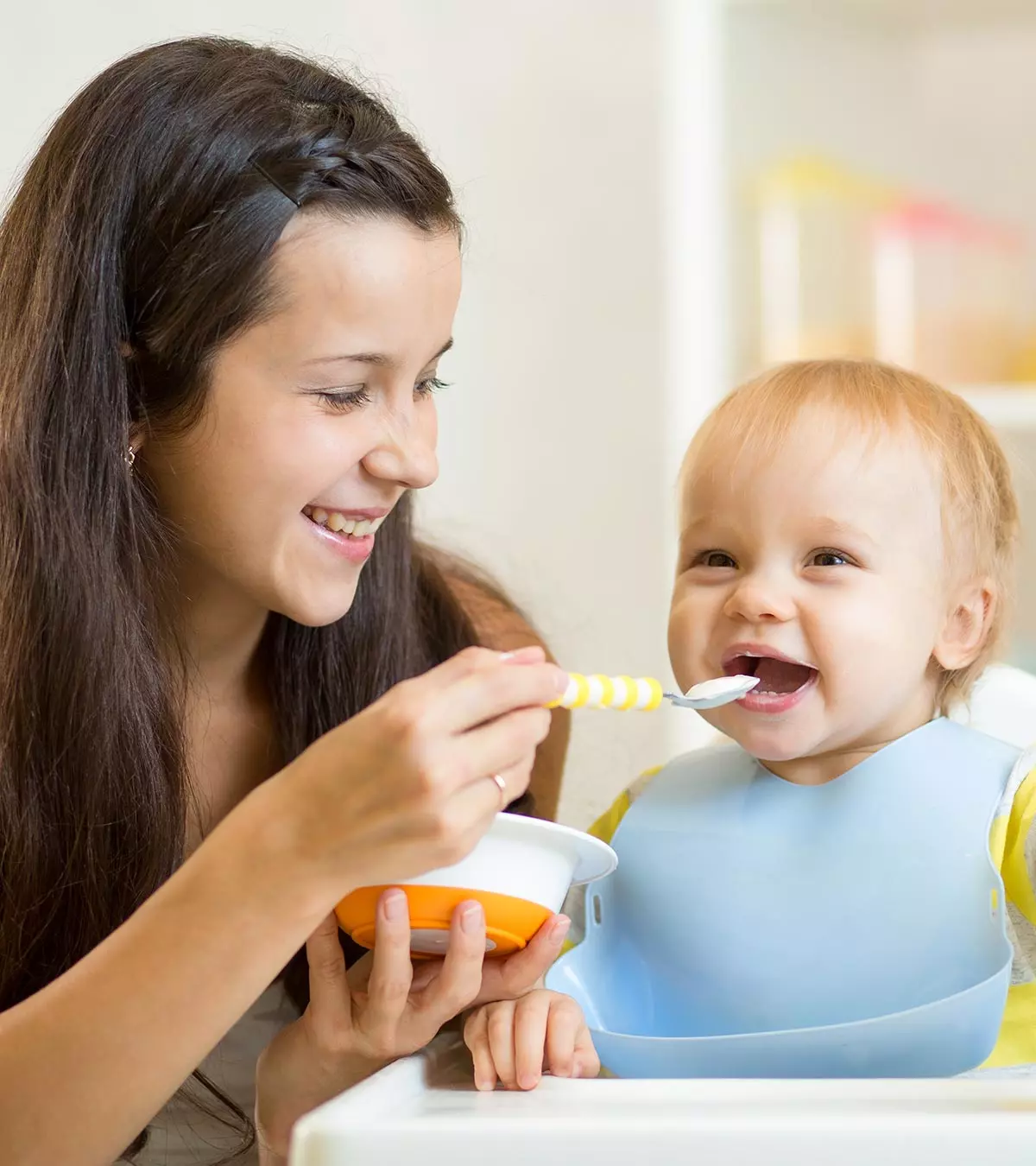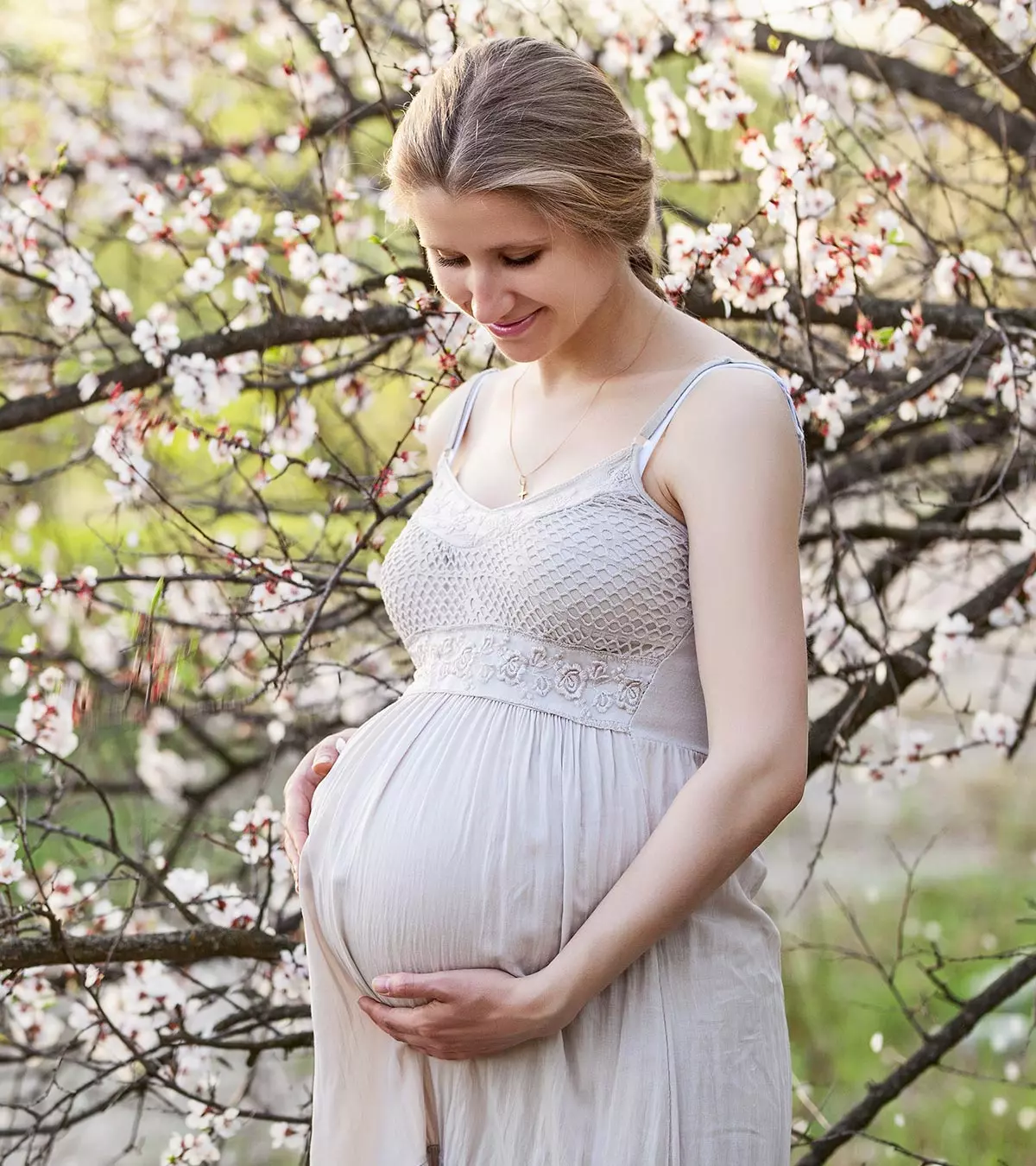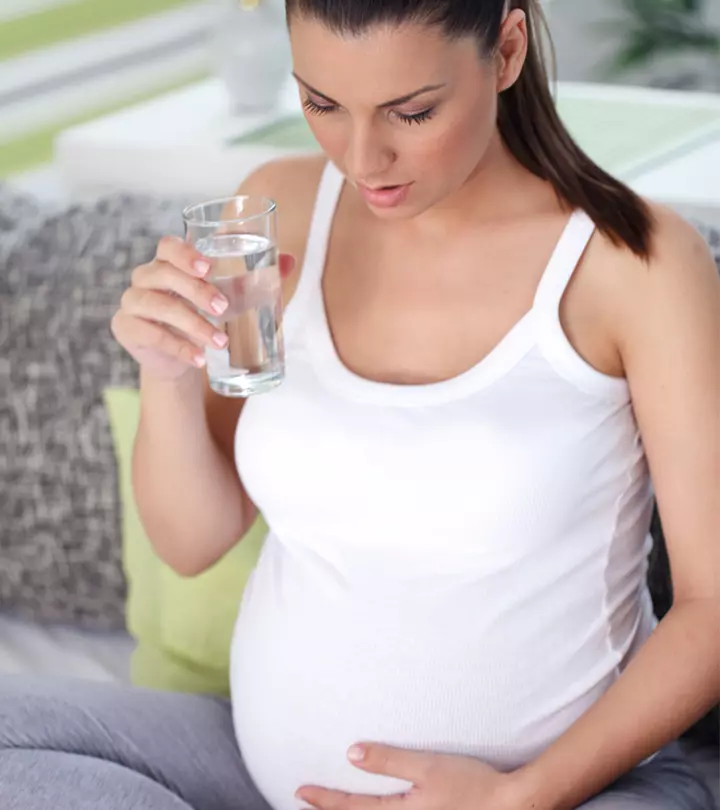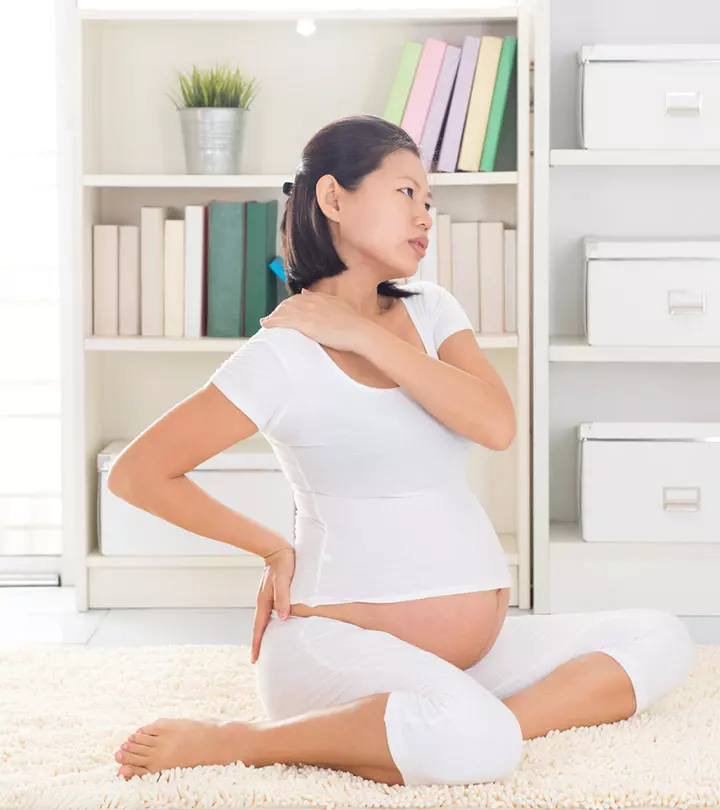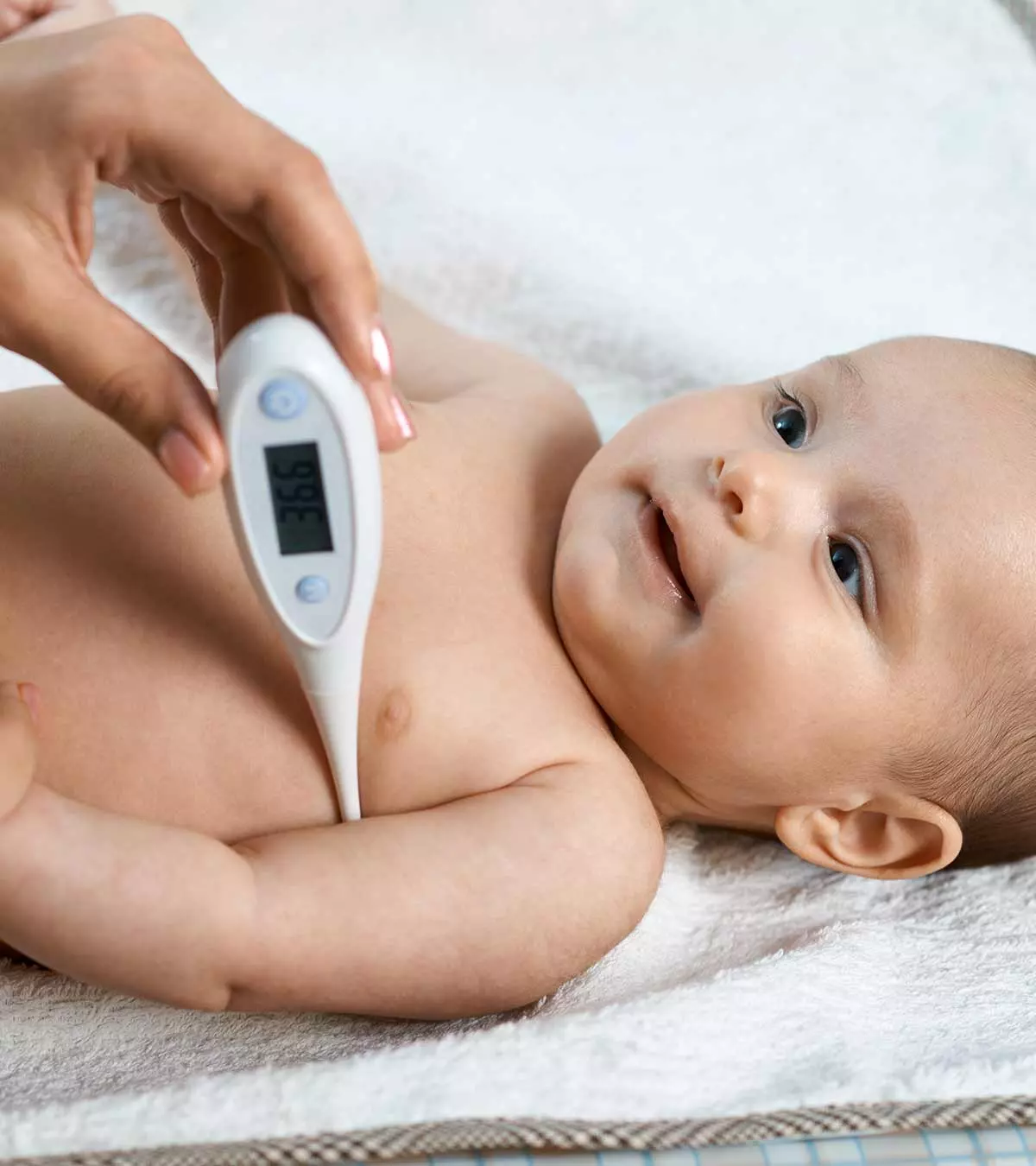
Image: ShutterStock
Parents prefer to use a digital thermometer instead of a conventional one (mercury thermometer) for safety reasons. However, most parents do not know how to take baby temperature with a digital thermometer. Measuring correct body temperature is crucial because it is a good indicator of the baby’s health. However, there are different ways of measuring the temperature, and they mostly depend on the age of the child and the type of thermometer used. This post explains in detail the different kinds of digital thermometers available and the correct way of measuring your baby’s temperature.
Key Pointers
- Ease of use, safety, and accuracy make digital thermometers preferable to conventional thermometers.
- Check temperatures in the forehead, armpits, ear, oral, or rectal areas; for ages three months to one year, rectal or forehead temperatures are recommended.
- Always use thermometers specifically designed for babies for safety purposes.
- Check the rectal temperature if the axillary, temporal, or tympanic assessment shows a reading of 99ºF or above to verify if it is a high temperature.
- To get accurate readings, refrain from taking the temperature after a shower or physical activity.
What Are The Types Of Digital Thermometers?
The type of digital thermometer depends on the part of the body where the temperature is checked (1).
- Standard multi-use digital thermometer: It is a regular digital thermometer with a metal tip that contains a heat sensor attached to an LCD screen. The screen shows temperature up to decimal points for accurate reading. It is used for oral (mouth), rectal (rectum), and axillary (armpit) temperature measurement.
- Tympanic (ear canal) digital infrared thermometer: This thermometer is used exclusively for ear canal temperature. It uses infrared beams, which detect heat levels through a sensor and display it on the LCD screen.
- Temporal artery (forehead) digital infrared thermometer: The thermometer is shaped in a way that it can be easily placed on a child’s forehead. It uses an infrared beam to measure the temperature of the blood flowing in the temporal artery of the forehead.
Digital thermometers are better than the conventional thermometers as they give an accurate reading and are safe due to the absence of mercury and glass. The American Academy of Pediatrics recommends the use of a digital thermometer for babies.
Age Guidelines To Measure Temperature
The way you take the temperature depends on the baby’s age (2).
- Temperature from rectal measurement is most accurate followed by forehead and armpit temperatures. Rectal temperature may be taken upto three years of age.
- Below three months of age armpit temperatures are safe to take. Recheck if it is above 99° F or use rectal reading.
- Ear thermometers should be used once the baby is above six months.
- Rectal or forehead temperatures may be accurately used from three months to one year.
- Above four years of age oral temperature would suffice and give accurate results
What Is The Normal Temperature In Infants?
According to the American Academy of Pediatrics, the normal body temperature is between 97.5ºF (36.4ºC) and 99.5ºF (37.5ºC); 100.4ºF (38ºC) and higher is considered a fever in babies (3).
How To Measure Baby Temperature With A Digital Thermometer?
Here is how you can measure the baby’s temperature using a digital thermometer (4).
1. Rectal(Rectum) opening temperature

It is the most accurate mode of measuring body temperature as it shows the slightest of temperature changes. It can be safely done at home.
How to: Use a standard digital thermometer and label it for exclusive rectal use.
- Clean the thermometer with a cotton ball dipped in alcohol and then wipe it dry. or you can wash the tip with soap and water followed by a rinse. Apply some petroleum jelly on the tip of the thermometer as it acts as a lubricant for easy insertion, preventing discomfort.
- Lay the baby on the stomach on your partner’s lap, who should hold the child firmly. You can also put the baby on his back on a soft surface and fold his legs till the thighs.
- Gently spread the buttock cheeks so you can see the rectal opening properly. Slowly insert the thermometer for about half an inch into the anus till you can barely see the metal tip. For babies older than six months, you can insert it to about an inch. Do not go beyond it since it may hurt the baby’s bowel. Premark the thermometer so you know how far to insert.
- Hold the thermometer in position for two minutes until it beeps or till you get a reading on the LCD screen.
- Gently remove the thermometer and note down the temperature. Clean it thoroughly with alcohol before storing it.
 Point to consider
Point to consider2. Axillary(Armpit) temperature

Temperature can be measured by placing the standard digital thermometer in the baby’s armpit. However, this should be avoided in babies younger than three months as the reading would not be precise.
How to:
- Undress the baby waist above and hold him in a sitting position. Ensure that the underarm is dry.
- Clean the thermometer with alcohol-dipped cotton and place it in the baby’s underarm.
- Close the forearm and hold the elbow close to the infant’s body.
- Leave it there for five minutes or until the thermometer shows a reading. Note the temperature and clean the thermometer with alcohol. If you are taking the axillary temperature with mercury thermometer, then also, you need to keep it in place for five minutes.
3. Temporal Artery(Forehead) temperature

Use a digital infrared thermometer for checking forehead temperature.How to:
- Hold your baby in a sitting position and ensure their comfort.
- Bring the end of the thermometer close to the forehead. Read the instruction manual and follow the procedure as suggested in it. A digital infrared thermometer gives you a reading when you hold it close to the skin and swipe it left to right on the forehead without touching it.
- In the case of a contact-based digital thermometer, gently touch the sensor at the center of the baby’s forehead, press the scan button, and swipe to one side of the head up to the hairline. Release the scan button and note the temperature displayed on the thermometer’s screen in Celsius or Fahrenheit.
 Quick fact
Quick fact4. Tympanic(Ear) canal temperature
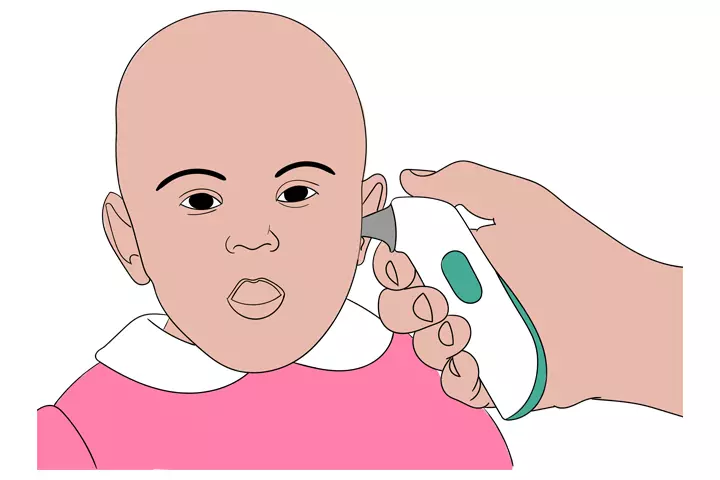
Never use a standard digital thermometer for tympanic temperature as you could accidentally damage the baby’s eardrum. Tympanic thermometers have to be held in the correct position for accurate reading. Excess ear wax could interfere with the measuring process.
How to:
- Place the tip of the thermometer at the ear canal as directed in the instruction manual. Insert the tip only till the marking.
- Time taken for measurement will depend on the thermometer and could last from a few seconds to a minute
- These thermometers are sensitive to position, and if you do not place them correctly, you will not get an inaccurate reading. Therefore, take two to three readings for accuracy.
- Do not use ear thermometers in infants younger than six months since their ear canal is too narrow for a thermometer probe.
5. Oral temperature

It is a standard body temperature assessment procedure used for adults as well.
How to:
- The child should not eat or drink anything hot or cold for 30 minutes before the temperature assessment.
- Make the child sit in a comfortable position. Clean the thermometer with alcohol and put it between the child’s tongue and floor of mouth. It should be held in place using tongue and lips, and not teeth.
- At four years, the child is old enough to hold the thermometer by himself if shown the procedure. However, do not leave the child unattended with it.
- Let the thermometer stay for three minutes and then record the temperature. Clean it thoroughly with alcohol and store the thermometer away. It is crucial to maintain proper hygiene to prevent any infections.
 Quick tip
Quick tip Remember, if you get a reading of 99ºF (37.2ºC) or above in axillary, temporal, or tympanic assessment, then immediately check the rectal temperature to verify if it is high temperature (5).
Points To Remember
It is important to keep certain points in mind before, during, and after taking the baby’s temperature with a digital thermometer.
- Do not check the temperature after a physical activity and after taking showers as it increases the body temperature and gives an inaccurate reading.
- Always follow the instructions in the product manual.
- Keep the thermometer away from the child’s reach even if he is older than four years to avoid a choking hazard.
- Clean the thermometer thoroughly before storing it away in a clean, cool, and dry place.
When To See A Doctor
A digital thermometer should give you an accurate reading to determine if the baby has a fever. There are some situations when you must see a doctor immediately (6):
- The baby is below three months and has a temperature of 99ºF (37.2ºC) or above, measured by any kind of thermometer. Newborns have a developing immune system, which is vulnerable to pathogen attack. This makes medical intervention necessary.
- The baby is between three and six months and has a temperature of 100ºF (37.8ºC) or more.
- The baby is older than six months and has a temperature of 102ºF (38.9ºC) or higher. Babies and even older children will show abnormal signs such as irritability, lack of interest in food, and chronic lethargy.
- Fever is often accompanied by health conditions such as cold, stuffy nose, or stomach problems such as diarrhea.
- Fever is accompanied by symptoms such as persistent crying, rash, lethargy, or trouble breathing.
Frequently Asked Questions
1. Can I use a digital thermometer on a baby?
Yes. It is always safe to use a digital thermometer to check your baby’s body temperature
(7).
2. How do I take an accurate temperature with a digital thermometer?
According to the American Academy of Pediatrics, the best place to check the body temperature in babies and toddlers up to three years for accurate results is the rectum (7).
3. Is there a difference between a baby thermometer and a regular thermometer?
Digital thermometers can be used for both adults and babies to check body temperature. Glass thermometers and fever strips are not recommended for infants and babies (8).
4. What type of thermometer is most accurate for babies?
The rectal thermometer is the most accurate for babies as it shows even slight temperature changes in the body. However, ensure you follow the manufacturer’s directions for proper use (7).
5. How can I comfort my baby while taking their temperature?
Stay calm and be gentle with your baby when checking their temperature. You can use their favorite toy or play soothing music to keep them engaged. Consider when they are most likely to be calm, such as after feeding or a nap. Hold your baby close in a cuddling position to provide a sense of protection and comfort.
Parents and caregivers need to know how to take the baby’s temperature with a digital thermometer. This helps to understand when the baby has a fever. Remember to note the temperature readings and accompanying symptoms to share with your pediatrician during visits. Giving your doctor such valuable insights can be beneficial since they can suggest the best treatment. The digital thermometer shows measurements on the screen. For example, you may measure the rectal temperature of babies younger than three months and up to six months of age. Up to four years, the axillary temperature is monitored, and oral temperature is measured post four years of age.
Infographic: Things That May Alter Temperature Reading
A baby’s body temperature could vary based on several factors. Here are some vital points that could aid you in taking appropriate readings. Save this infographic to skim through it while checking your baby’s temperature. Illustration: Momjunction Design Team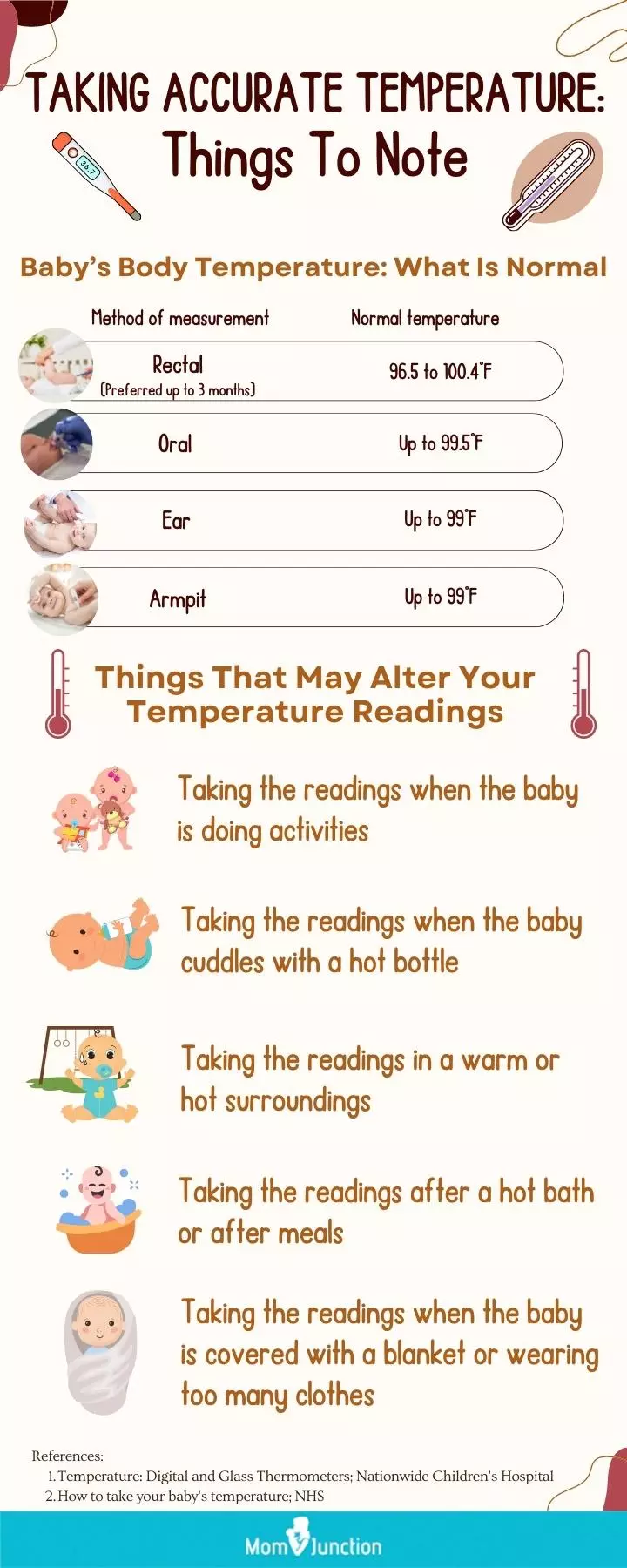
Illustration: How To Take Your Baby&039s Temperature With Digital Thermometer?
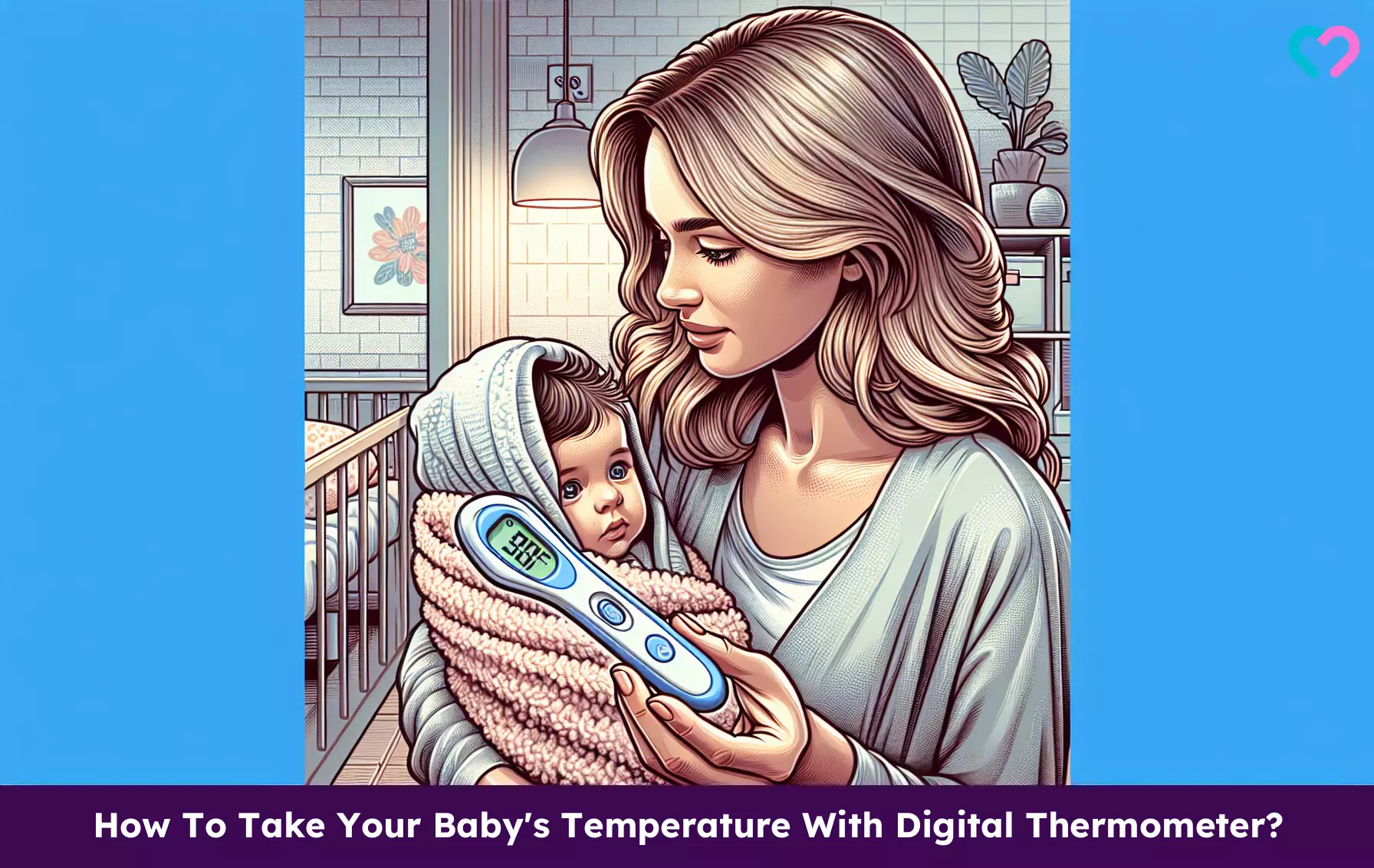
Image: Stable Diffusion/MomJunction Design Team
Watch this informative video on using an underarm thermometer to measure your baby’s temperature effectively. Gain valuable insights and expert techniques for precise temperature readings.
References
- How to Take Your Child’s Temperature.
https://www.healthychildren.org/English/health-issues/conditions/fever/Pages/How-to-Take-a-Childs-Temperature.aspx - Temperature management.
https://www.rch.org.au/rchcpg/hospital_clinical_guideline_index/Temperature_management/ - Signs and Symptoms of Fever.
https://www.healthychildren.org/English/health-issues/conditions/fever/Pages/Signs-and-Symptoms-of-Fever.aspx - Temperature: Digital and Glass Thermometers.
https://www.nationwidechildrens.org/family-resources-education/health-wellness-and-safety-resources/helping-hands/temperature-digital-and-glass-thermometers - Fever – How to Take the Temperature.
https://www.seattlechildrens.org/conditions/a-z/fever-how-to-take-the-temperature/#:~:text= - Fever in Infants and Children.
https://www.msdmanuals.com/home/children-s-health-issues/symptoms-in-infants-and-children/fever-in-infants-and-children?ruleredirectid=743#:~:text=Children%20without%20warning%20signs%20who - Taking a Baby’s Temperature.
https://www.healthychildren.org/English/health-issues/conditions/fever/Pages/How-to-Take-a-Childs-Temperature.aspx#:~:text=There%20are%20different%20types%20of,are%20accurate%20if%20done%20properly. - Temperature: Digital and Glass Thermometers.
https://www.nationwidechildrens.org/family-resources-education/health-wellness-and-safety-resources/helping-hands/temperature-digital-and-glass-thermometers
Community Experiences
Join the conversation and become a part of our nurturing community! Share your stories, experiences, and insights to connect with fellow parents.
Read full bio of Dr. Anuradha Bansal
Read full bio of Rohit Garoo
Read full bio of Rebecca Malachi
Read full bio of Ghazia Shah








